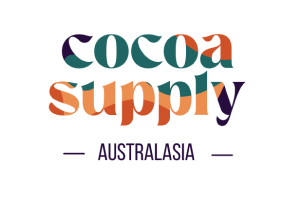Between sourcing ingredients, planning a menu that will stand out, and finding your voice as a brand, launching a bakery is no easy task. It’s common to overlook small but important details that shape your final products. One of the most important choices you’ll make is choosing your cacao.
We work with all sorts of food innovators around the world at CocoaSupply, and we’ve seen firsthand how the right ingredient choices and combinations can elevate your entire brand.
First things first: Understand the Basics
1. Cacao Powder
There are different types of cacao powder. At CocoaSupply, we offer 4 types. Natural 10/12, Alkalized 10/12, Natural 20/22, and Alkalized 20/22. What do these mean and how do you know which one you need?
Natural cacao powder is light brown and is naturally slightly acidic. It retains its full aroma and antioxidants. It’s best suited for recipes using baking soda, or for those wanting a more intense cacao flavor.
Alkalized cacao powder (also known as “dutched”) is a bit darker in color, and is smoother/ less acidic, making it more soluble and commonly used in beverages, fudges, and baking recipes that rely on baking powder for leavening.
The 10/12 means that it contains approximately 10-12% fat, or cacao butter. 20/22 means that it contains approximately 20-22% fat. The higher fat results in a thicker product, ideal for rich and dense chocolate desserts or creamy hot cocoa.
2. Cacao Butter
Cacao butter is more than an ingredient for chocolate bars. It’s a rich plant-based fat that can add shine and smoothness to any dessert. It melts at human body temperature, so nothing will give you that delicious melt-in-your-mouth experience like cacao butter. It doesn’t go rancid quickly like most plant-based oils due to its molecular structure, and can be extremely versatile.
We offer cacao butter in both its natural pure prime pressed form, which is simply the fat extracted from the bean, and in deodorized form. We don’t use any solvents or chemical agents, ever. Our deodorization process only uses steam to remove most of its aroma. This makes it a neutral fat that can blend easily into almost anything, when you don’t want a chocolate smell.
You can use cacao butter for ice cream, especially in vegan ones that need to rely on fats outside of dairy. Cacao butter is very common in many vegan pastries for that reason, such as croissants, glazes, frostings, etc.
When you do want that delicious chocolate aroma to come through, then natural cacao butter is your best friend. You can use it for truffles, bonbons, ganaches, etc.
3. Cacao Liquor
Cacao liquor (also known as paste or mass) is what you get when you grind cacao nibs into a smooth, thick paste. It contains both cacao solids and cacao butter in approximately equal parts, and it’s the base of chocolate. It’s essentially 100% baking chocolate: as pure as it gets.
Our fine aroma cacao beans come from small sustainable farms in Ecuador, known for being the highest quality. It’s important to work with ingredients that will offer the type of unforgettable experience that will make them come back. You can use our Ecuadorian cacao liquor as a base for ganache, custom chocolate blends, fillings, chocolate chips, glazes or sauces. It allows you to tailor the sugar and flavor to your exact recipes.
4. Cacao Nibs
Talk about texture, bitterness and crunch all in one!
Cacao nibs are simply crushed and shelled cacao beans. They bring a bold, intensely flavored crunch to baked goods, smoothie bowls, barks, granolas, chocolate bars, you name it. They also offer a positive visual appeal, and are packed with antioxidants. The wellness crowd will be very excited to see these anywhere on your menu.
Our cacao nibs are dried with warm air, but you can further roast them to bring out different flavor profiles.
Creative Extras to Differentiate Your Bakery
Beyond the basics, we offer a range of creative ingredients for those who like to experiment or build signature flavors:
Freeze-dried fruits: Dragonfruit, hibiscus, passionfruit, cacao fruit pulp, and more! These are great for juices, smoothies, fillings, chocolates, flavoring or coloring glazes naturally.
Premium vanilla: We also carry whole and ground Tahitian vanilla beans, perfect for high-end pastries and custards.
Tips for New Bakeries
If you’re just starting out, here are a few things we’ve learned from working with hundreds of small and growing bakeries:
Choose ingredients you can scale with: It’s tempting to experiment with everything at once, but starting with a few versatile ingredients will make the process less overwhelming.
Think visually and functionally: Customers eat with their eyes. Presentation matters!
Label wisely: Customers today care a lot about origin and ethics. Knowing the sourcing of your cacao gives you an edge in branding and transparency.
Document your experiments: When you’re mixing cacao liquor into a mousse for the first time or playing with butter ratios in frostings, take notes! Some of your best recipes will come from trial and error.
Starting a bakery is a brave, creative, and fun endeavor. The right products will make a difference, but how you use them is what makes it yours.
